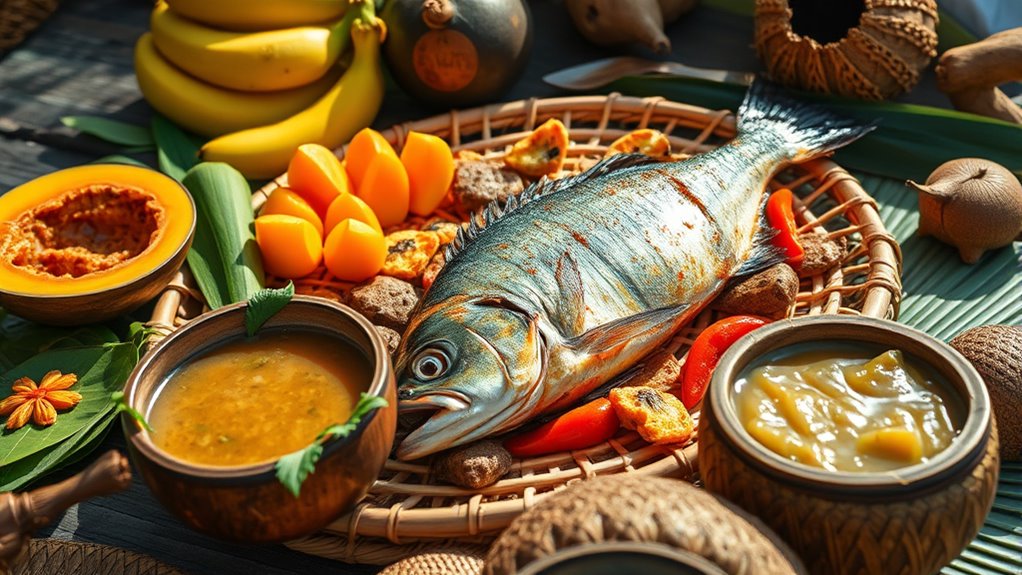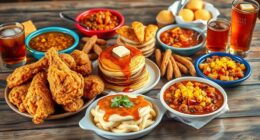Micronesian cuisine centers on traditional ingredients like taro, breadfruit, yams, bananas, and coconuts, which symbolize land and sea connections. You’ll find ancient cooking techniques such as underground baking, boiling, and steaming, creating signature dishes like chicken kelaguen. Today, modern influences blend international flavors into local dishes, while cultural practices emphasize communal feasts and sustainability challenges. Explore further to discover how these vibrant culinary traditions continue to evolve and thrive across Micronesia.
Key Takeaways
- Traditional Micronesian cuisine centers on land and sea ingredients like taro, breadfruit, yam, coconut, and seafood, reflecting cultural identity.
- Cooking methods such as underground ovens, boiling, steaming, and frying preserve flavors and are integral to cultural rituals.
- Signature dishes include chicken kelaguen and taro fritters, highlighting resourcefulness and local ingredients.
- Modern influences introduce fusion elements like stir-fried seafood, soy sauce, and international flavors into traditional recipes.
- Food practices emphasize communal sharing, celebrations with pigs and coconuts, and face challenges from overharvesting and imported foods.
Indigenous Staples and Their Cultural Significance

Indigenous staples like taro, breadfruit, yam, banana, and coconut form the foundation of Micronesian cuisine, reflecting deep cultural connections to the land and sea. You rely on these crops daily, as they sustain your community and symbolize your relationship with nature. Taro and yam, often baked or boiled, serve as comforting, essential foods, while breadfruit offers versatility—steamed, mashed, or baked. Bananas provide quick energy, and coconuts are everywhere, used for milk, oil, and cooking. These ingredients aren’t just food; they embody tradition, identity, and resourcefulness. Their cultivation and preparation are deeply rooted in local customs, passed through generations, and adapted to island environments. Embracing these staples helps you preserve Micronesia’s unique culinary heritage amid modern changes. Understanding these ingredients deepens appreciation for their cultural significance and the skills involved in their preparation.
Traditional Cooking Techniques and Signature Dishes
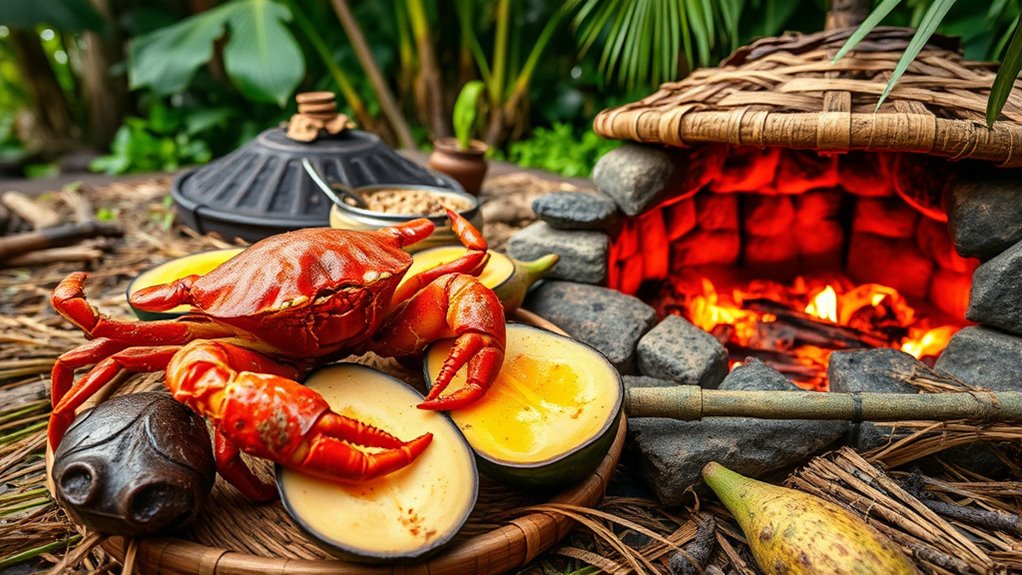
Traditional cooking techniques in Micronesia rely heavily on age-old methods that highlight your resourcefulness and bond with nature. You often use underground ovens called umw, where you bury root crops, meats, and seafood for slow cooking. Another common method is boiling or steaming foods in coconut milk, enhancing flavor and tenderness. You also prepare signature dishes like chicken kelaguen by shredding chicken, mixing it with coconut, and adding lemon juice. To deepen your understanding, here’s a quick comparison:
| Technique | Signature Dish |
|---|---|
| Underground baking (umw) | Root crops with coconut milk |
| Boiling/Steaming | Chicken kelaguen |
| Frying | Yapese taro fritters |
These methods preserve flavors, connect you to tradition, and showcase your culinary ingenuity. Exploring cooking techniques can help you better appreciate the cultural significance behind these methods.
Fusion and Modern Influences on Micronesian Cuisine
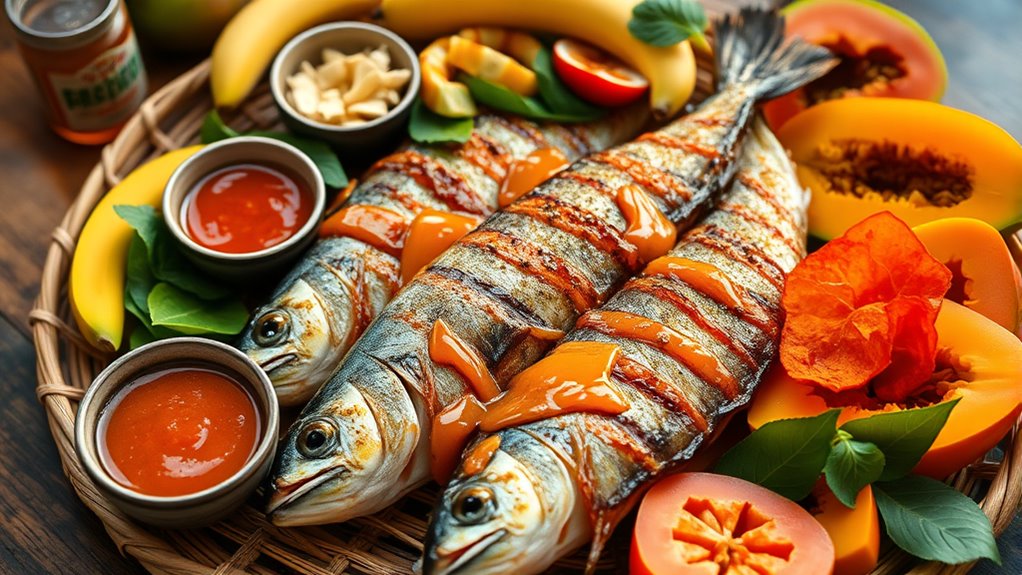
Modern Micronesian cuisine has evolved considerably as globalization influences local eating habits and culinary practices. You now see a mix of traditional ingredients with international flavors, creating exciting fusion dishes.
1. You’ll notice stir-fried fish and vegetables, blending Chinese techniques with local seafood and produce.
2. Soy sauce, imported meats, and spices like ginger and garlic appear in reinterpretations of traditional recipes.
3. Urban centers serve dishes that combine island flavors with Western and Asian influences, from burgers with local toppings to noodle bowls infused with Micronesian spices.
4. Incorporating local ingredients and traditional cooking methods helps preserve the culinary heritage while embracing new influences.
While communal dining persists, menus now reflect a dynamic culinary landscape that honors heritage while embracing modern trends. This fusion showcases how Micronesia’s cuisine continues to adapt and thrive in a globalized world.
Unique Foods and Culinary Specialties of the Region
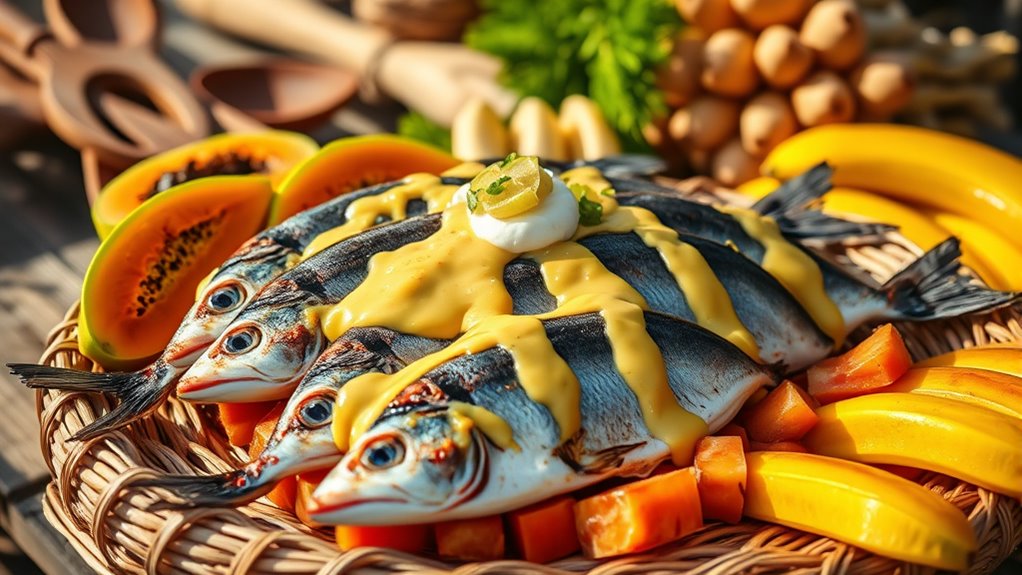
Micronesia offers a variety of unique foods and culinary specialties that reflect its rich cultural heritage and diverse local ingredients. You’ll find dishes centered around root crops like taro, breadfruit, yam, and banana, often cooked with coconut milk or in underground ovens. Seafood, especially reef fish, shellfish, and crabs, forms the backbone of many traditional meals. A notable delicacy is the coconut crab, prized for its size and flavor, though now rare due to conservation efforts. Pohnpei pepper chicken showcases locally grown peppers, while Yapese taro fritters serve as a sweet snack. Chamorro red rice adds vibrant color and flavor, and sashimi-style tuna highlights the region’s fresh catch. These foods embody Micronesia’s resourcefulness and deep connection to its natural environment. Embracing traditional culinary practices helps preserve cultural identity and promotes sustainable food sourcing.
Food Practices, Celebrations, and Sustainability Challenges
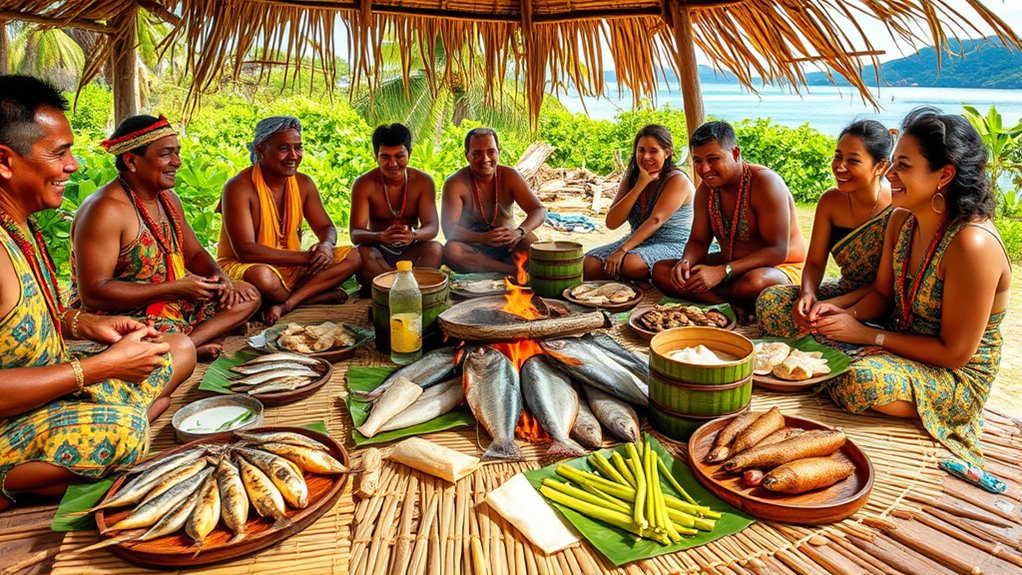
Food practices in Micronesia are deeply rooted in community and cultural rituals that emphasize sharing and collective participation. During celebrations, you’ll find pigs central to feasts, symbolizing status and unity. Traditional methods like underground ovens (umw) cook root crops and meats slowly, fostering communal bonding. Modern influences have introduced new ingredients and fusion dishes, yet local customs remain strong.
Here’s what you should notice:
- Pigs and coconuts play a vital role in ceremonial gatherings, highlighting social bonds.
- Betel nut chewing and communal eating reinforce social ties and cultural identity.
- Sustainability faces challenges from overharvesting species like coconut crabs and increasing reliance on imported foods, threatening traditional diets and ecosystems.
Frequently Asked Questions
How Do Micronesians Preserve Their Traditional Recipes Amid Globalization?
You preserve Micronesian traditional recipes by passing them down through generations, practicing communal cooking, and maintaining cultural pride. You use local ingredients like taro, coconut, and seafood, sticking to traditional methods such as underground ovens. Despite globalization, you keep the flavors alive by celebrating festivals, sharing family recipes, and teaching younger generations. This dedication guarantees your culinary heritage remains strong while adapting to modern influences.
What Role Do Food and Feasts Play in Micronesian Social Hierarchy?
Food and feasts act as symbols of status, markers of community, and expressions of identity. You participate in elaborate preparations, share abundant dishes, and honor traditions through ceremonies. These gatherings elevate the social hierarchy by showcasing wealth, hospitality, and respect. You witness how the size, quality, and variety of the feast reflect your standing, reinforcing bonds while celebrating your culture and affirming your place within Micronesian society.
Are There Any Specific Dietary Restrictions or Taboos in Micronesian Culture?
You should know that Micronesian culture has few strict dietary restrictions, but some taboos exist. For example, certain taboo foods may vary by island or family, such as avoiding specific seafood or animals during particular ceremonies or times of the year. You’re encouraged to respect local customs, especially during traditional events, and ask elders about any food restrictions, as they’re deeply tied to cultural beliefs and social harmony.
How Sustainable Are the Traditional Fishing and Harvesting Practices Today?
Like a fragile web spun by ancestors, traditional fishing and harvesting in Micronesia face strain today. You should know, overharvesting and habitat loss threaten fish, coconuts, and coconut crabs, risking the delicate balance of ecosystems. While locals still rely on sustainable practices, increased demand and climate change challenge these methods. To protect this vibrant tapestry, ongoing efforts focus on conservation and respecting natural limits, ensuring future generations inherit a thriving environment.
What Impact Has Tourism Had on Micronesian Culinary Traditions?
Tourism has introduced new food trends and increased demand for local ingredients, which can strain traditional practices. You might notice more fusion dishes or imported foods in restaurants, overshadowing indigenous recipes. While tourism boosts the economy, it also risks eroding authentic culinary heritage if not managed sustainably. You can help by supporting local eateries that preserve traditional recipes and promoting responsible tourism that respects Micronesian food customs.
Conclusion
You might think Micronesian cuisine is just simple island fare, but it’s rich with traditions and flavors that tell stories of culture and resilience. Even if you’re used to other cuisines, trying their signature dishes and unique ingredients offers a fresh perspective. Embrace the fusion of old and new, and you’ll discover a vibrant culinary heritage worth exploring. It’s not just food; it’s a way to connect with Micronesia’s heart and history.

